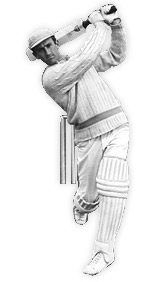

CRICKET
The basics of batting and bowling are copiously documented in any number of coaching books – and yet I know of no really good “self taught” player. Unlike golf where a dedicated youngster can spend every daylight hour hitting balls on his own, cricket practice usually needs at least two people each of whom can both bat and bowl. Hence the incidence of a number of brothers (and brother/sister pairings) who both excel.
 Even then they will need a well prepared playing surface plus other expensive amenities and equipment including a net, bats, balls, gloves and pads. So the usual way to improve skills is at school or at a cricket club where such facilities already exist, with the added bonus of (hopefully) helpful coaches. Both batsmen and bowlers must learn to adapt to many different situations and conditions because “billiard table” pitches are few and far between. There is no substitute for actually playing matches.
Even then they will need a well prepared playing surface plus other expensive amenities and equipment including a net, bats, balls, gloves and pads. So the usual way to improve skills is at school or at a cricket club where such facilities already exist, with the added bonus of (hopefully) helpful coaches. Both batsmen and bowlers must learn to adapt to many different situations and conditions because “billiard table” pitches are few and far between. There is no substitute for actually playing matches.
More interesting perhaps are the more subtle tenets of the game which, once learned and properly understood, will stand anyone in good stead at whatever playing standard he or she has reached: in batting AND bowling.
Batting:
To bat well, you need to achieve the right blend of concentration and relaxation. Too much of one at the expense of the other will downgrade performance.
Know where your stumps are. It sounds obvious. But there are “good” leavers of the threatening ball just wide of target and many who are less good. It is important to practise this key element of batting.
Have the courage to wait. Anyone who is in a bad run of form is usually guilty of moving too early. The strange but true equation is that the longer you wait before moving, the more time you seem to have to play the ball.
If you wait that extra fraction of a second, you pick the length better. Playing forward or back to the wrong length is a more likely cause than any other for getting out.
It is fun to practise the art of “waiting”. Test yourself until you know your limits. In a match, one of the neatest tricks against a spinner is to stay stock still to a widish ball, and as it hits the keepers gloves, pretend that you never saw the ball at all!
Stepping to leg is not a move you will find in the coaching manual. I know of a sports master who would stand behind the batsman with a metal spike just touching the player’s backside. “Come on” he would say “bowl away”. Backing away from the line of the ball was not an option.
Remember that the bat should be either vertical or parallel to the ground for any and every stroke. There is a greater element of risk every time it is used at 45 degrees.
Good running between wickets depends on total trust in your partner’s call. Do NOT second guess his judgement by “ball watching”. Just keep your eyes on the caller and respond – whether it is YES or NO.
ENOUGH FOR NOW
Bowling:
Remember that line is more important than length. If you can bowl a line then the Captain can set a field – with variations for different batsmen.
Rythm and balance are the keys to consistency. Oh! and don’t forget our old friend “relaxation”.
Short pitchers should only be bowled with a purpose. The “half tracker” as they call them in Australia usually means runs.
Realise that bowling “success” (or lack of it) can be judged in a number of ways: How many wickets you take. What is your strike rate? i.e. How many overs or balls you bowl per wicket taken. What is your economy rate – both runs per wicket and runs per over?
It is the lack of understanding of these subtleties that make the continued publication of traditional bowling averages such an insult to the intelligence.
It is a fact that some bowlers “move” the ball more than others. And they are not always the result of a perfect looking action. If you find you are not moving the ball as compared with other team members, be bold and experiment with the way you hold the ball.
Change of pace and change of angle are very under-exercised skills. If I ever skipper a team again in the after life, I shall encourage my quick bowlers to bowl their ”slower ball” at least once in the first two overs – even if they risk giving away a run or two. And to bowl from close and wide on a regular basis.
Be reasonably forgiving of fielding errors and dropped catches. If you put the fear of God into the culprit, he/she may tense up and repeat the mistakes.
Listen carefully to the Captain and try to follow his wicket taking strategy. But remember that, in the end, taking wickets at reasonable cost is down to you and nobody else. Economy is only really important by way of ensuring that the Captain is happy to keep you on!!
MORE THAN ENOUGH FOR NOW except:
Cricket is a sideways game – always was and still is.